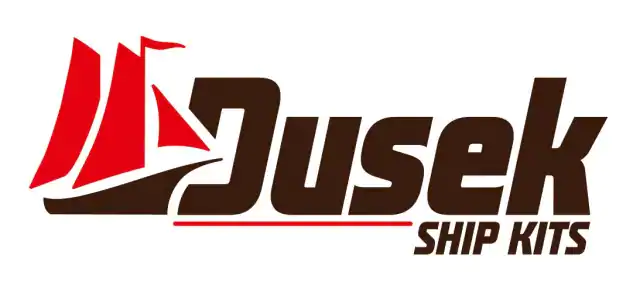Dušek Ship Kits
| Naam | Omschrijving | Afbeelding |
|---|---|---|
| Dutch Statenjacht | History: Statenjacht is the type of ship used since the 17th century in Holland for transportation of important government or corporate personalities. These ships feature a flat bottom, rounded bow and stern richly decorated. Cannon on board the ship were used for saluting and signaling. Ships of this type were normally from 18m to 21m long. This particular model represents a Statenjacht in the service of the Dutch East India Company (VOC-Vereenigde Oost-Indische Compagnie). Scale: 1/48 length: 505mm, width: 175mm, height: 500mm Van deze boot is er een manual [of meer dan 1] te vinden op de pagina Modellen Manuals [Deze pagina is voor iedereen toegankelijk] | 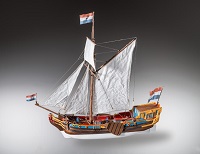 |
| Nuestra Senora | Nuestra Señora de la Concepción y de las Ánimas was the first Spanish three decker. Construction of the ship was begun in 1682 by the master builder Antonio de Amas and she was launched in 1687 at the Colindres shipyard in Cantabria. She had a displacement of about 1500 tons. There are two sources for reconstruction of the ship; first is the book “Arte de Fabrica Reales” from 1691 which contains some drawings, and second is a painting in the parish church “Iglesia de la Asunción” in Arcenillas, Zamora. Scale: 1/72 Length: 905 mm, Width: 415mm, Height: 815mm Van deze boot is er een manual [of meer dan 1] te vinden op de pagina Modellen Manuals [Deze pagina is voor iedereen toegankelijk] | 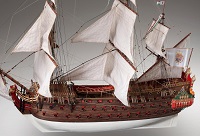 |
| La Real | La Real, built in Barcelona at Royal Shipyard, was the flagship of Don Juan de Austria during the battle of Lepanto in 1571, Battle of Lepanto was the Largest battle between galleys in history, in which a Christian fleet of the Holly League defeated an Ottoman fleet under admiral Ali Pasha. In 1971, a replica of La Real was built and displayed in the Museu Marítim in Barcelona. Scale: 1/72 Length: 795mm, Width: 380mm, Height: 640mm Van deze boot is er een manual [of meer dan 1] te vinden op de pagina Modellen Manuals [Deze pagina is voor iedereen toegankelijk] | 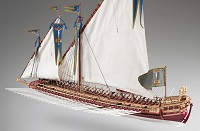 |
| La Belle Poule | The Belle Poule is school schooner of French navy. The Belle Poule together with her sister ship Etoile was launched at shipyard Féchamp at Normandy on 8 February 1932. The Belle Poule is 37,5m long and has displacement 225tons. The ship is able to sail up to 12.5 knots with using of sails and up to 9 knots if she is powered by diesel engine. Scale: 1/50 Length: 755 mm, Width: 255mm, Height: 655mm Van deze boot is er een manual [of meer dan 1] te vinden op de pagina Modellen Manuals [Deze pagina is voor iedereen toegankelijk] | 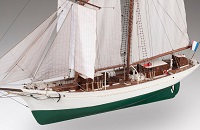 |
| San Martin | The San Martin was flagship of famous Armada Invencible (Invincible Fleet) under the command of the Duke of Medina Sidonia in 1588. San Martin sustained heavy damage in the battle of Gravelines by a group of English ships. The San Martin was originally built as a Portuguese galleon Săo Martinho in 1580. There are no available original plans or construction drawings of the San Martin but it is supposed that the ship was about 180 feet long and had about 1000 tons displacement. She carried 48 guns of different calibres. Scale: 1/72 Length: 840 mm, Width: 345mm, Height: 700mm Van deze boot is er een manual [of meer dan 1] te vinden op de pagina Modellen Manuals [Deze pagina is voor iedereen toegankelijk] | 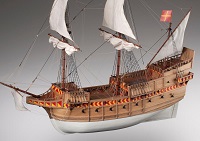 |
| Le Cerf | The cutter LE CERF was build after the plans of well known French ship designer Denys. The CERF was launched in March 2, 1779 in Saint-Malo dock-yard. Command of the ship was confided to ensign Varages. The ship was equipped with eighteen 6pdr guns. Total number of ship crew was from 155 to 194 persons (this numbers involve officers, seamen, gunners and mariners). Scale: 1/72 Length: 685mm, Width: 255mm, Height: 520mm Van deze boot is er een manual [of meer dan 1] te vinden op de pagina Modellen Manuals [Deze pagina is voor iedereen toegankelijk] | 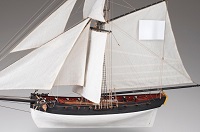 |
Le Cerf+turned brass gun barrels | Version of Le Cerf kit with turned brass gun barrels Van deze boot is er een manual [of meer dan 1] te vinden op de pagina Modellen Manuals [Deze pagina is voor iedereen toegankelijk] | 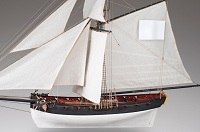 |
| Golden Hind | Golden Hind was a ship of Sir Francis Drake during his circumnavigation of the globe between years 1577-1580. Original name of the ship Pelican but Drake renamed her just during the voyage in 1578. There are no available original plans or construction drawings of the Golden Hind but it is supposed that the ship was about 25 meters long and had about 120tons displacement. The ship was armed by 18 guns of various calibres. This model was basically reconstructed after pictures of Golden Hind on Hondius’ map of the world from 1595. Scale: 1/72 Length: 500mm, Width: 225mm, Height: 460mm Van deze boot is er een manual [of meer dan 1] te vinden op de pagina Modellen Manuals [Deze pagina is voor iedereen toegankelijk] | 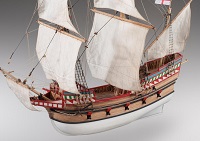 |
| Maria HF31 | Maria HF 31 is a fishing Ewer whose home base was Finkenwerder in northern Germany. Maria HF31 operated in the North Sea for more than 70 years in the period from 1880 to 1950. During this period the vessel has Scale: 1/72 Length: 365 mm, width: 85mm, height: 295 mm Van deze boot is er een manual [of meer dan 1] te vinden op de pagina Modellen Manuals [Deze pagina is voor iedereen toegankelijk] | 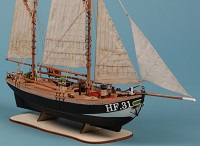 |
| Hanse Kogge | The Hansa was a medieval association of German cities which engaged by in long distance business mainly in area of Baltic Sea. An origin of the Hansa is probably possible to find in fellowship of Gotland’s merchants in the 12th century. Later a main center of the Hansa was in city of Luebeck. Other important hanseatic cities were for example also Hamburg, Koln, Rostock, Danzig, Stralsund, Elblag, Riga and many others. The golden age of the Hansa was a 14th century and just the most widely used type of ships in 14th century was a Cog. To these days a lot of contemporary illustrations of the Cogs from 14th century are survived and also any wrecks were found. This model represents one of largest cog from first half of the 14th century. Scale: 1/72 Length: 430mm, Width: 210mm, Height: 330mm Van deze boot is er een manual [of meer dan 1] te vinden op de pagina Modellen Manuals [Deze pagina is voor iedereen toegankelijk] | 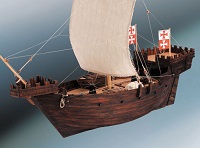 |
| Greek Trireme | The model represents a Greek Trireme from the age of battle of Salamis (480 B.C.). The crew were 170 oarsmen and about 30 warriors. Under favourable conditions, trireme could fly at up to 12 miles per hour. The major weapon of the trireme was a bronze ram which penetrates the side of enemy vessels. Main propulsion was rowing. Sails were used only for lasting longer voyages. During battle the sails and the mast were lay down and the ship was powered only by oars. Scale: 1/72 Length: 515mm, Width: 180mm, Height: 220mm Van deze boot is er een manual [of meer dan 1] te vinden op de pagina Modellen Manuals [Deze pagina is voor iedereen toegankelijk] | 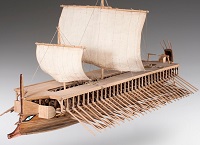 |
| Greek Bireme | The model represents the Greek bireme from the 6th Century before Christ. The garrison force was created by 50 oarsmen, who were sitting in two rows one above another (on each side 25) and by about another 10 soldiers. In the event of struggle the oarsmen left the oars and skulls and fought with the shields and swords. The protrusion on the forward of the ship served for sinking of the enemy ships, the boat strove to crash by that into the hull of the adversary boat. The ship was handled by two rudders on the stern. The main drive of the ship was oared, the sail served only for longer lasting voyages. During the battle the sail together with the mast were down swept on stern and the ship was driven entirely by oars. Scale: 1/72 length: 395mm, width: 185mm, height: 160mm Van deze boot is er een manual [of meer dan 1] te vinden op de pagina Modellen Manuals [Deze pagina is voor iedereen toegankelijk] | 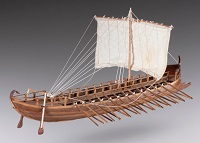 |
| Viking Longship | This model represents the similar long ship which was found near the village of Skuldelev at Denmark and which is known as Skuldelev 2. The original was constructed primarily of oak wood about the year 1060 in Dublin. The ship had a length of 30 meters and width of 3.8 meters. The ship could sail with 60-100 Viking warriors onboard and was driven by a large rectangular sheet. In the case of no wind, there were 60 oars. Scale: 1/35 Length: 850mm, Width: 370mm, Height: 475mm Van deze boot is er een manual [of meer dan 1] te vinden op de pagina Modellen Manuals [Deze pagina is voor iedereen toegankelijk] | 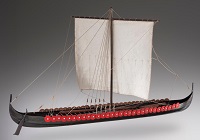 |
| Viking Gokstad | This model represents a Viking ship found in year 1880 near village Gokstad in Norway. The ship was built in second half of ninth century. Excellent nautical ability of the ship was demonstrated in the year 1893 when a replica built by Magnus Anderson took a journey from Norway to USA. Total length of the ship was 24m. A keel and planks were made from oak wood. The ship was propelled by 32 oars and one rectangular sail. Scale: 1/35 Length: 610mm, Width: 270mm, Height: 370mm Van deze boot is er een manual [of meer dan 1] te vinden op de pagina Modellen Manuals [Deze pagina is voor iedereen toegankelijk] |  |
| Viking Knarr | The Knarr is a type of Viking ship which serves for long trade naval business. The Knarrs were very robust and very well resist against unfavorable conditions in open sea. This model represents the similar Knarr which was found near the village of Skuldelev at Denmark and which is known as Skuldelev 1. The original was built in Norway between years 1030 and 1050 mainly from oak and pine. Length of the ship was about 16.3m and displacement about 24 tones. Scale: 1/35 length: 440mm, width: 300mm, height: 400mm Van deze boot is er een manual [of meer dan 1] te vinden op de pagina Modellen Manuals [Deze pagina is voor iedereen toegankelijk] | 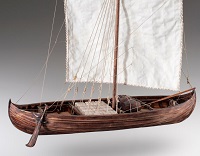 |
| Santa Maria | Santa Maria was the flagship of Christopher Columbus on his first voyage to America. On August 1492 Santa Maria, Pinta and Nina started their voyage to America in Palos de la Frontera port in southwest coast of Spain. After two months at 12 October sailors saw a land. There are no exact drawings of the Santa Maria but it is supposed that a length of hull of the ship was about 35 meters and displacement about 200tons. Scale: 1/72 length: 465mm, wide: 250mm, height: 445mm Van deze boot is er een manual [of meer dan 1] te vinden op de pagina Modellen Manuals [Deze pagina is voor iedereen toegankelijk] | 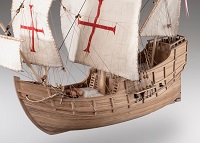 |
| Nina | The Nina was a ship in a fleet of Christopher Columbus on his voyage to America. Other ships were flagship Santa Maria and Pinta. The voyage of the Christopher Columbus starts in August 1492 in port Palos de la Frontera. After two months at 12 October sailors saw a land. There are no exact drawings of the Nina but it is supposed that a length of hull of the ship was about 20 meters and displacement about 100tons. Scale: 1/72 Length: 340mm, Width: 100mm, Height: 360mm Van deze boot is er een manual [of meer dan 1] te vinden op de pagina Modellen Manuals [Deze pagina is voor iedereen toegankelijk] | 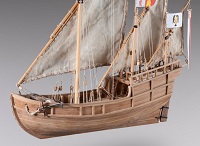 |
| Pinta | The Pinta was a ship in a fleet of Christopher Columbus on his voyage to America. Other ships were flagship Santa Maria and Nina. The voyage of the Christopher Columbus starts in August 1492 in port Palos de la Frontera. After two months at 12 October sailors saw a land. There are no exact drawings of the Nina but it is supposed that a length of hull of the ship was about 20 meters and displacement about 100tons. Scale: 1/72 Length: 385mm, Width: 180mm, Height: 320mm Van deze boot is er een manual [of meer dan 1] te vinden op de pagina Modellen Manuals [Deze pagina is voor iedereen toegankelijk] | 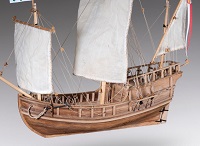 |
| Viking Longship 1/72 | This model represents the similar longship which was found near the village of Skuldelev at Denmark and which is known as Skuldelev 2. The original was constructed primarily of oak wood about the year 1060 in Dublin. The ship had a length of 30 meters and width of 3.8 meters. The ship could sail with 60-100 Viking warriors onboard and was driven by a large rectangular sheet. In the case of no wind, there were 60 oars. Scale: 1/72 length: 390mm, width: 185mm, Height: 236mm Van deze boot is er een manual [of meer dan 1] te vinden op de pagina Modellen Manuals [Deze pagina is voor iedereen toegankelijk] | 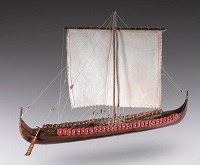 |
| Viking Gokstad 1/72 | This model represents a Viking ship found in year 1880 near village Gokstad in Norway. The ship was built in second half of ninth century. Excellent nautical ability of the ship was demonstrated in the year 1893 when a replica built by Magnus Anderson took a journey from Norway to USA. Total length of the ship was 24m. A keel and planks were made from oak wood. The ship was propelled by 32 oars and one rectangular sail. Scale: 1/72 Length: 305mm, Width: 135mm, Height: 185mm Van deze boot is er een manual [of meer dan 1] te vinden op de pagina Modellen Manuals [Deze pagina is voor iedereen toegankelijk] | 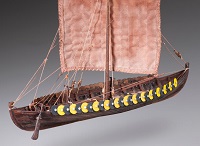 |
| Viking Knarr 1/72 | The Knarr is a type of Viking ship which serves for long trade naval business. The Knarrs were very robust and very well resist again unfavorable conditions in open sea. This model represents the similar Knarr which was found near the village of Skuldelev at Denmark and which is known as Skuldelev 1. The original was built in Norway between years 1030 and 1050 mainly from oak and pine. Length of the ship was about 16.3m and displacement about 24 tones. Scale: 1/72 Length: 220mm, Width: 150mm, Height: 200mm Van deze boot is er een manual [of meer dan 1] te vinden op de pagina Modellen Manuals [Deze pagina is voor iedereen toegankelijk] | 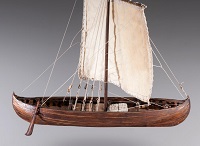 |






